Wondering whether you really need to prime paving slabs, concrete blocks, cobbles or porous pavers such as sandstone? Read on to find out why priming the underside of pavers before laying them reduces cracks, breaks and even reflective stains, plus our expert guide to priming pavers.
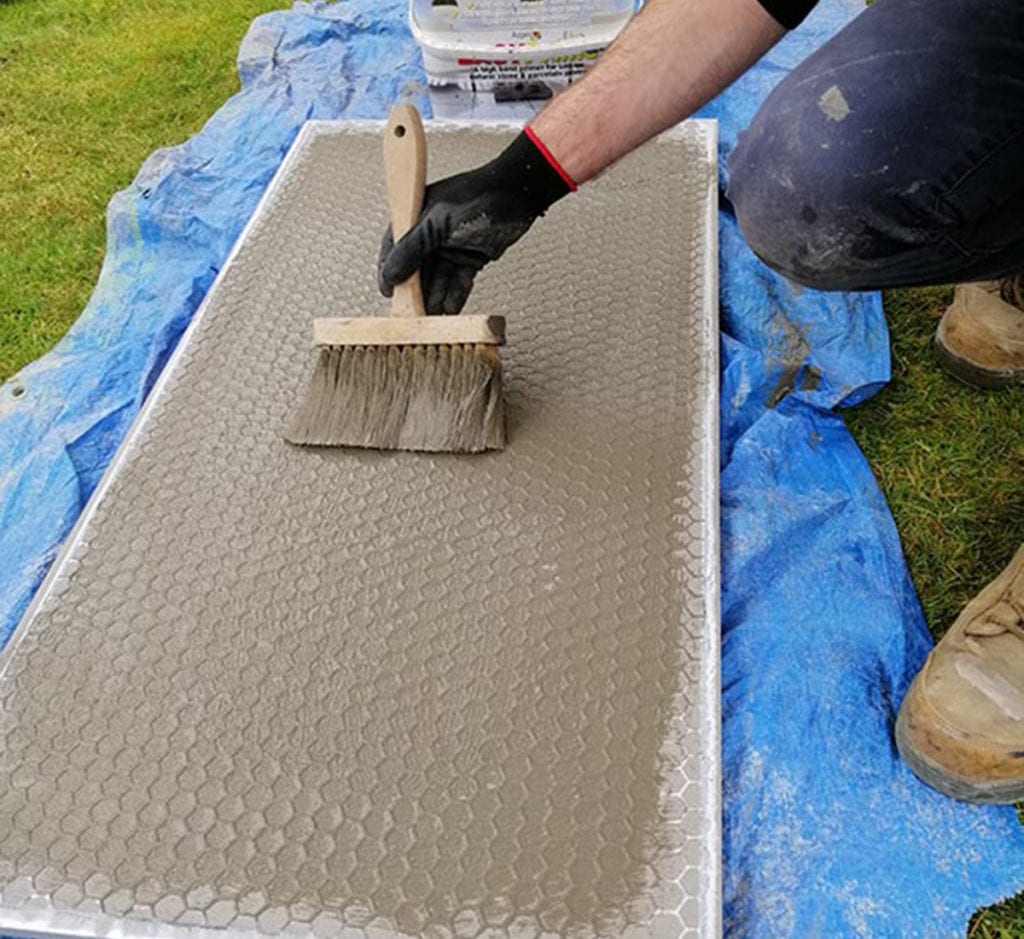
What is a paving primer?
A primer is an extra-strong adhesive – otherwise known as a bonding agent – that effectively secures paving slabs to bedding mortar, reducing the risk of movement and reflective stains.
A high-quality primer will seriously extend the life of your hard landscaping project. Find out more about the types of primers below.
Before we go any further, let’s be crystal clear about what we mean as a ‘primer’.
A primer is sometimes referred to as a slurry primer, slurry coat, priming layer, bonding agent or bond bridge. They are all the same thing: you are basically bonding the paving slab to the bedding layer.
There are other great benefits to using a primer on your paving. We go into those in more detail below.
Do I need to use a primer?
There are many commonly used phrases bandied around the landscaping industry. One of them is: “It’s a crime not to prime!”.
All types of paving slabs, stones and cobbles will benefit from a primer. However, you must always use a paving primer before laying impermeable pavers such as porcelain, granite or slate. They will not bond to the bedding mortar without it.
When it comes to porous or permeable stones, like limestone and sandstone, they will also benefit from a primer as it will help prevent reflective stains.
Landscaping experts say that if you want a project that lasts for years, skipping using a primer is likely to get you in the dog house with your clients and handling one of those gut-wrenching phone calls that a job was not fully up to scratch.
By adding a priming layer between the paving and the bedding mortar you will ensure a high bond strength, which prevents this type of failure from occurring.
This in turn increases the life expectancy of the paved area and reduces its ongoing maintenance and potential repercussions of having to return to completed paving projects – and unhappy customers.
So what does a primer do? Read on to find out the benefits and which types of primers to use and when.
Benefits of priming pavers
The overall benefits of applying a primer include:
- Reduces cracks and breaks in the mortar
- Protects pavers from efflorescence
- Secures non-porous slabs in place
Let’s take a look at each one of these benefits in turn to see how a primer can prolong the life and quality of your paving.
A primer reduces the risk of mortar cracks
You may already be well aware that the major cause of cracks and breaks in paving mortar is not to do with the paving grout. In actual fact it’s down to the pavers moving, which causes the mortar to break.
Let’s take the example of a Belgian block paver.
If you laid the slab directly onto the bedding mortar (with no primer), and then jointed to finish the project, over time those paving slabs may start to move as they ‘debond’ from the bedding mortar.
As the mortar is the only thing that is really securing the pavers in place, any slight movement will cause that mortar to crack and break.
And if those Belgian block pavers are on a driveway and receive regular vehicle traffic, the mortar is likely to crack sooner rather than later.
Now imagine the same scenario but you have primed each block paver before laying and fitting them securely to the mortar bed before you start grouting.
Once the project is complete, the pavers do not suffer from the same type of movement because they are fully bonded to the bed below.
And you have fewer – or none – of the tell-tale mortar cracks.
A primer reduces the risk of efflorescence
A high-quality primer is an essential tool in a landscaper’s arsenal for the fight against efflorescence.
Efflorescence, or reflective staining, can be a particular problem when laying porous stones such as limestone, concrete blocks and Indian sandstone.
There are many reasons why efflorescence occurs (we cover all the details in this article), but one of the major causes is from failing to prime pavers before laying them.
Alongside providing an exceptional bond between the bed and the slab that we mentioned about earlier, a slurry primer also provides an impermeable protective layer.
It is this protective layer that helps to prevent water and salts from being absorbed into the porous stone. When the stone dries, the moisture evaporates and – voila – we have reflective stains.
Don’t be fooled by thinking that only porous stones are affected by efflorescence. Non-porous stones, such as porcelain, can also exhibit the ‘picture frame’ effect.
Regardless of which type of stone you use, it’s best practice to use a primer each time.
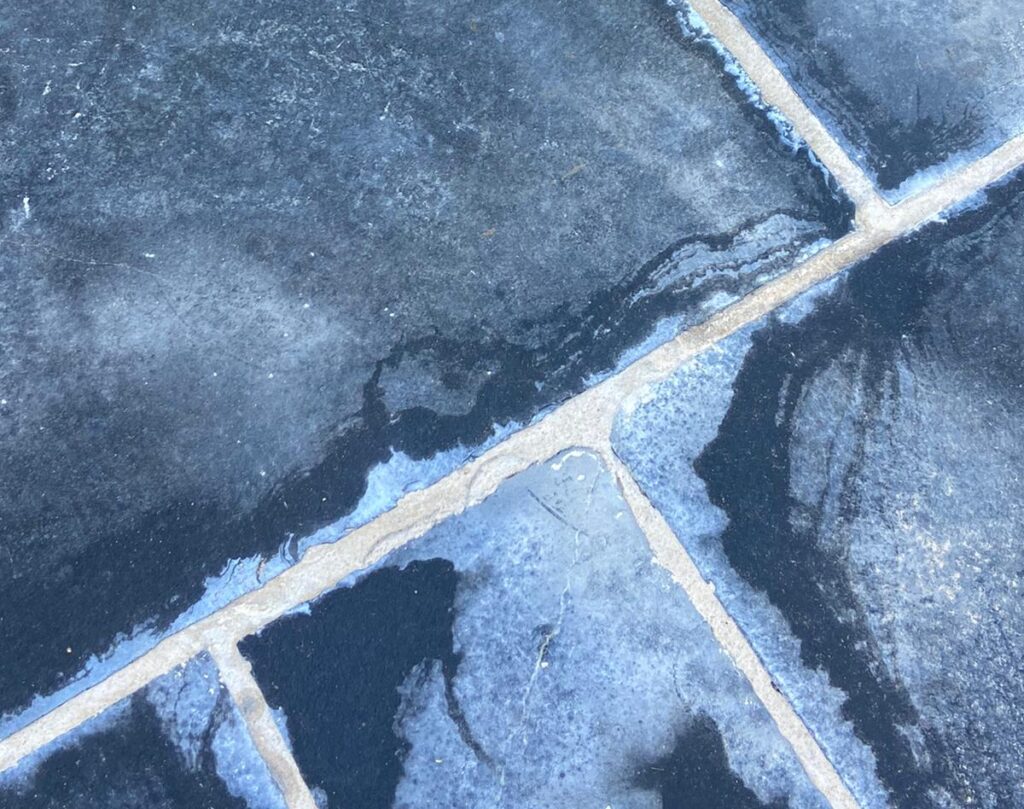
When it comes to efflorescence, prevention is always better than a cure. Although there are paving cleaners that can help, we always recommend preventing it from happening in the first place. It saves those angry phone calls from disgruntled clients too!
A primer secures non-porous slabs in place
You may be wondering why we’re over-egging the bonding benefit of primers, but this is particularly important if you’re laying impermeable – or non-porous – paving slabs.
If your hard landscaping job involves porcelain, granite, slate or another type of non-porous stone, you’ll certainly need to use a primer to secure these materials in place.
Being non-porous, these types of slabs – and especially porcelain as it is completely impermeable – will not bond at all with the bedding mortar.
Permeable stones, such as sandstone and concrete, will bond to the bedding through their porosity and capillaries.
But with impermeable stones this porous cement-bonding does not occur at all. They’ll need an extra hand from a primer with exceptional strength.
A slurry primer acts like a glue to secure these stones in place.
Read on to find out which primers we recommend for certain materials and types of paving jobs.
Types of paving primers
There are three main types of paving primers to choose from:
- Slurry primers
- SBR primers
- Porcelain primers
Let’s take a deeper look into each of these and see which is best for your project.
Slurry primers
We’ve talked a lot about primers in general already. But what’s the deal with slurry primers?
Slurry primers offer the strongest bond and best protective layer for securing pavers and preventing efflorescence, respectively.
The name is a bit of a giveaway, but with slurry primers you generally add a powdered mixture to water to create a slurry before painting this onto the underside of paving slabs (read on to see the finer details of how to prime slabs with priming slurry).
Some of the most popular slurry primers are:
Pro-Prime from UltraScape
One of the best slurry primers on the market. Pro-Prime offers an outstanding bond to secure pavers in place, and is even highly recommended for use with porcelain. One 20kg bag will cover the underside of 15 square metres of paving.
Practically impermeable, Pro-Prime also forms a barrier on the bottom of the pavers to prevent minerals and salts being drawn up from the ground below and creating those unwanted efflorescence stains.
Like many of the other quality products from the team at UltraScape, Pro-Prime meets and exceeds the strict demands of the British Standard BS 7533 and as such is part of the UltraScape Mortar Paving System.
Mark Talbot, Director of MPave Ltd, has used many different primers and bonding agents on the hundreds of commercial and domestic projects he’s worked on over the years. These have included “the early days of PVA”, cement, Ronafix and then onto primers such as Pro-Prime.
He shares, “We’ve tried many different products over the last few decades and have come to respect Ultrascape’s Pro-Prime and Flowpoint.
“When installed correctly, in our opinion, there is nothing else on the market that can match the strength and longevity of these two products.”
"In our opinion, there is nothing else on the market that can match the strength and longevity of [Pro-Prime and Flowpoint]."
Mark Talbot, MPave Ltd
Larsen Streetscape PS
Another high quality brush-on slurry primer that also adheres to BS7533 is Larsen Streetscape PS Priming Slurry.
Prem-Prime from UltraScape
Another good choice, particularly for the DIY market because of its more accessible size and packaging, is Prem-Prime slurry primer.
Available in a easy-to-mix, 17kg bucket, Prem-Prime is another cementitious bonding agent that offers a high-strength bond between all types of paving stones and cobbles and the UltraScape’s range of mortar beds, such as EcoBed and Perma-Bed.
If you weren’t aware, Prem-Prime is actually the same formula as Pro-Prime – and both made by the same manufacturer. The only difference is the quantity and the handy packaging.
SBR primers
Styrene butadiene rubber is a bit of a mouthful on its own, so the other type of paving primer is called an SBR primer.
An SBR primer, such as Nexus ProJoint High Performance SBR, offers increased durability making it ideal for paving areas subject to heavy traffic. They can be used for protecting light coloured paving slabs against efflorescence.
SBRs have a high level of resistance to salt permeation, which is all down to their fantastic resistance to water and vapour. They block the absorption of water and salts and therefore help to stop efflorescence in its tracks.
SBR primers can also stop discoloration coming through soft stone.
Some believe that SBR primers are just a PVA glue, but they’re far from it. Once dried, PVA glue can still be affected by water. SBRs are completely resistant to water.
When you choose a quality bonding mortar like Pro-Prime or Larsen PS, there is no need to add an SBR to the mix to improve adhesion. Read more about using SBRs in our more recent article on bonding mortars.
SBRs can be used as an admixture for mortar, screeds or renders.
Porcelain primers
As vitrified paving, porcelain lacks the microscopic capillaries that are found in permeable materials like concrete and sandstone.
As such, porcelain can be a difficult paving material to prime, which is where porcelain primers come in.
Technically also a slurry primer, ProJoint Porcelain Primer by Nexus is specially designed for porcelain paving and ceramic tiles.
Remember, UltraScape’s Pro-Prime (mentioned earlier) also works on porcelain pavers. Handy if you don’t want to branch-out to another product for just the one porcelain paving job.
Top tips on how to prime paving slabs
Here are some quick tips on how to mix and apply a priming slurry.
You should always follow the manufacturer’s instructions, but this insider advice will help you get the most from your priming layer each and every time.
How to mix priming slurry
- Only add fresh, clean water
- Add the exact amount of water required – always use a measuring jug (that means no guess work!)
- Always add the mixture to the water
- Use a paddle mixer to combine the water and formula
- Aim for a smooth, lump-free consistency
- Mix the primer slurry away from clean patio slabs to avoid any unwanted spills
How to prime pavers
- Always use gloves to avoid getting priming slurry on your hands
- Paint the slurry onto the underside and sides of a paving slab using a thick brush – a paint brush or roller work great
- Always paint the primer to the very edges of the slabs (this is when a vacuum lifter like the Grabo Plus works wonders)
- For cobbles and smaller setts, simply dip the underside of pavers in the mixture
- Apply the primer at a thickness of 1–2 mm
- Once applied, immediately secure the slab in place on the bedding mortar
- Only ever apply the slurry to the underside of pavers

Avoid spills and clean as you go
As an exceptionally strong bonding agent, the last thing you want to do is get priming slurry on your hands (incidentally, we always recommend using gloves!) or, maybe more importantly, any product surfaces.
Use tarps or plastic sheets to protect paving and other surfaces from primer spills.
If slurry primer does get onto the surface of your product, remove it immediately with a soaked wet sponge. Mark explains, “If the primer cures, it will be a bugger to get off!”
Likewise, you should ideally clean your tools as soon as possible after laying the pavers. Splashes from slurry primer will be difficult – if not impossible – to remove.
Contact our expert team for tailored advice
At The Paving Experts, we specialise in supplying and distributing a wide range of materials for highway maintenance, urban regeneration, commercial hard landscaping and domestic paving projects. Explore our full range.
Get in touch if you’d like some further advice on primers – our friendly team is on hand weekdays from 8.30am to 5.30pm on 0330 122 1025.

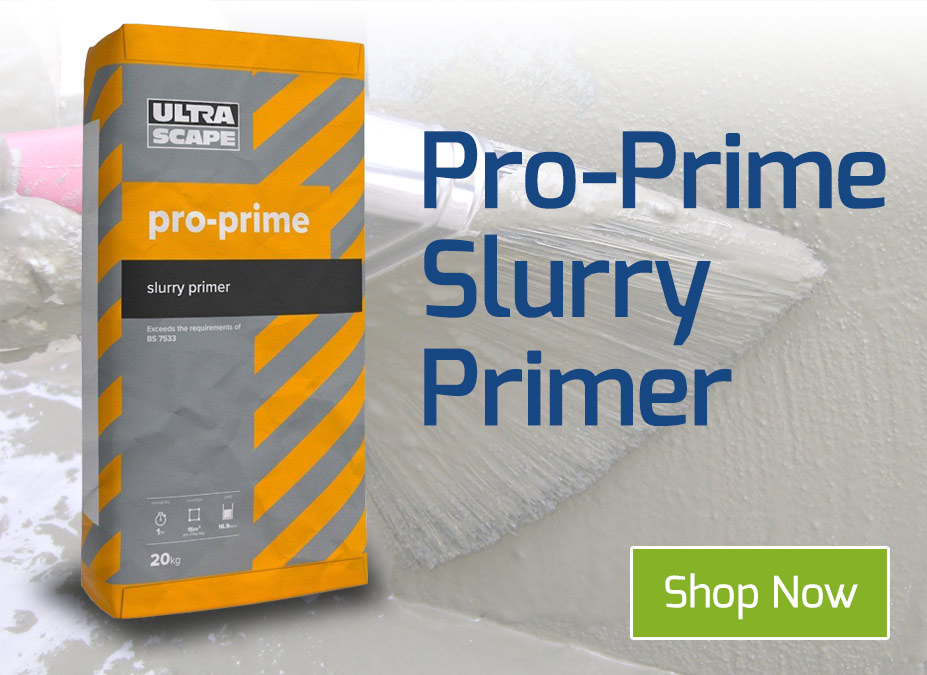


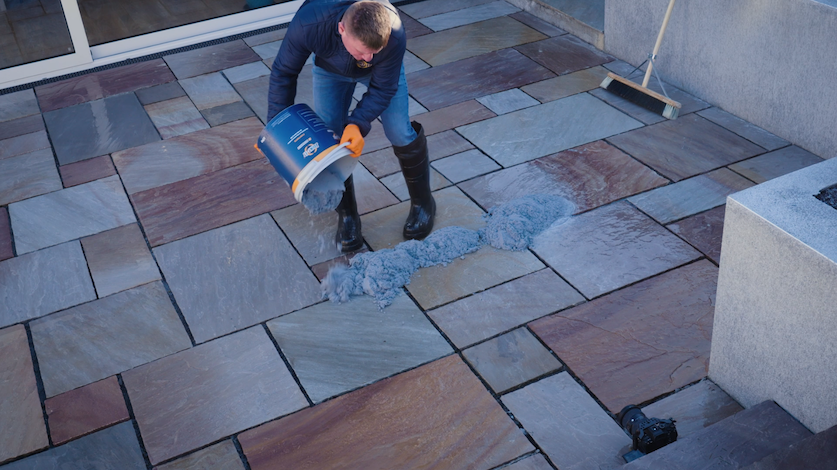
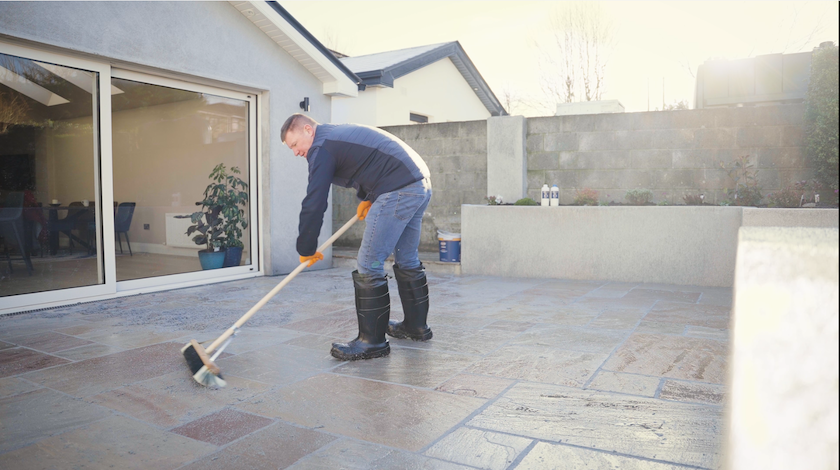


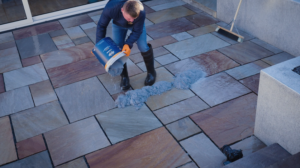

12 thoughts on “To prime or not to prime? A guide to priming pavers”
Can you put slurry primer on porcelain slabs and let it set before laying?
Hello Sandy, sincere apologies we didn’t see your question sooner. Slurry primer is designed to be wet laid, if you leave it to dry on the face of your slabs, it won’t provide the bond or the adhesion you need. The slurry primer should be ‘painted’ onto the underside and sides of pavers, and laid onto the bed immediately. If you need any further advice, please contact us on 0330 122 1025 or email us at orders@thepavingexperts.co.uk
Hi, can you tell me if I was to use the Ultrascape pro prime on the back of our porcelain tiles, could I then use an SBR mixed within the mortar bed for added bonding? Would the two products work together and is the extra bonding needed within the mortar bed or unnecessary? Thanks
Hi Emily, apologies for the late reply.
In answer to your question about using an SBR with Pro-Prime, Pro-Prime itself is intended as a direct alternative to SBR. As such, there is no need to use the two together. The main benefits of Pro-Prime over SBR is that it has been scientifically formulated to give exact bond (adhesion) rates (2.20N/mm2 after 28 days) and of course its BS7533 compliant.
If you have any further questions, please don’t hesitate to get in touch with our team on 0330 122 1025 or through orders@thepavingexperts.co.uk
Hi
I coated a slab with slurry primer and then realised the tile was chipped on one corner. I didn’t use the slab but now I would like to use it for a cut. Can I re-prime this tile? It has dried slurry primer on it.
Thanks
Hello Julius, we’d advise not – especially if you are a professional landscaper doing this for a client, better to use a new tile. However, if this is a domestic patio that you are doing for yourself, you could ty and clean the primer off the back of the tile, and re-prime it, but the bond and adhesion may not be as strong as if you were to use a new clean tile. It’s a judgement call, you may find if you reuse the slab it de-bonds and you have to relay it next summer. If you need any further help, please don’t hesitate to give us a call on 0330 122 1025 or email us at orders@thepavingexperts.co.uk. Take care, Cleo.
Hi, can I use SBR primer on vitrified porcelain outdoor slabs?
Hello we’d recommend using Ultrascape Pro-Prime rather than SBR – SBR can be used but Pro-Prime has exceptional bond strength across all types of paving elements- if you’d like to give us a call for any further information please do feel free to ring us on 0330 122 1025.
Can you use Pro-prime slurry over a normal mix of sharp sand & cement? with 20mm outside porcelain tiles
Thanks
Mick
Hello Mick, UltraScape Pro-Prime is designed to be used externally with an impermeable, full contact mortar bed, wet on wet mortar to paving slab. I hope this helps, if you need any further information please don’t hesitate to give us a call on 0330 1221025. Thank you
Hello, I`d be grateful for your advice.
I laid an Indian sandstone patio a few years back, part on cement base and part on sand bedding. I have now lifted the slabs ( fairly easily) as the cement grouts have largely opened up and loosened. The main reason however is that the all the mortar bedded slabs are discoloured to a varying degree, whereas the sand bedded ones very much less so.
I have now purchased new slabs and want to avoid repeating my mistakes so I intend to apply slurry to the underside to hopefully resolve the discolouration.
My questions are should I need to break up the old bedding
mortar (big Job) or will the application of the slurry be sufficient for a bond to the old base? ( the mortar contact areas on some slabs are not uniform but not so extreme on some slabs)
The other question is would it help if I SBR`d the edges of the slabs to prevent any possible discolouration from jointing compound?
I`d be grateful for your valued advice.
Rob, (Learn by experience DIY`er )
Hi Rob, no problem. Best practice would be to break up the old bed, however priming the back of the slabs will help reduce the risk of any staining. Ideally you should have a full wet bed. SBR is an alternative to priming so there is no need to do both. Hope that helps. Give us a call if you need any extra help.